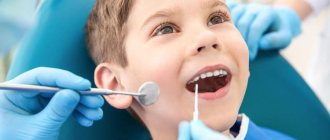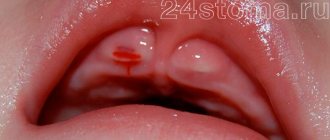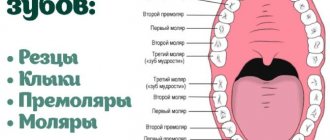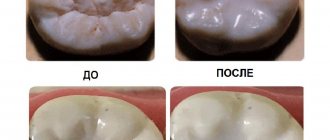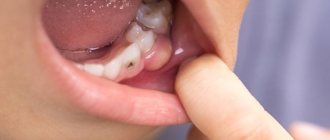- Classic comprehensive hygiene in 3 stages (ultrasound + air-flo + polishing) - 3,500 - 4,600 rub
- Periodontal cleaning of one segment (light) - 2,600 rub.
- Periodontal cleaning of one segment (medium degree) - 3,000 rub.
- Periodontal cleaning of one segment (severe) - 4,000 rub.
- Periodontal cleaning in the area of one tooth - 580 rub.
- Removal of a periodontal tooth during periodontal cleaning - 650 rub.
- Vektor therapy (Vector therapy) - 1st visit (90 min.) - 8,818 rub
- Vektor therapy (Vector therapy) - repeat visit (90 min.) - 7,334 rub
- Vektor therapy (Vector therapy) -1 tooth (20 min.) — 305 rub
Do your gums hurt? This means that you are developing an inflammatory process in your gums or have a painful tooth. When the cause of pain is in the tooth, the pain is local and does not spread to surrounding tissues. If your gums hurt, the cause may be periodontitis. Thus, the gum itself can be the cause of pain or it can serve as a symptom of another process.
When it comes to gum disease, the pain spreads to all or most of the teeth. This picture is especially characteristic of the development of gingivitis and periodontitis.
If you notice that the gums around a tooth or several teeth are swollen, red in color and bleeding, then we are most likely talking about gingivitis. If gingivitis is not cured, the process will go further and periodontitis will develop. If it seems to you that the gums near the tooth are swollen, then you need to promptly contact a periodontist for treatment, which must be carried out responsibly, since periodontitis can develop even if periodontitis is not treated well enough.
With periodontitis, the symptoms of gingivitis appear in a much more intense form, in addition, periodontal pockets begin to fester, and the necks of the teeth become exposed.
The initial stage of inflammation (gingivitis) - pain is felt in all gums. Further, when inflammation develops into periodontitis, pustules appear on the gums, and the pain intensifies around one/part of the teeth. The localization of the pain is explained by a periodontal abscess in the area of one of the periodontal pockets, in this case you may notice how the gums around a specific tooth are swollen. The main reason for the development of diseases of this nature is poor oral hygiene. The soft plaque covering the teeth tends to harden over time into a dense growth on the teeth, forming tartar. It is in the stone that pathogenic bacteria live comfortably, which provoke inflammatory processes in the gums and the appearance of pain. Therefore, it is necessary to both treat the gums and get rid of stone deposits, as well as eliminate carious areas of the tooth.
Saying goodbye to gum pain
If your gums are sore and swollen, what should you do first? No, don’t use a plot from your mother’s best friend’s neighbor’s great-grandmother. All “spells” for dental problems are in the hands of the dentist, and only he knows how to correctly “spell” gums from pain and bleeding.
Inflammatory processes occurring in the teeth and gums in the case of periodontitis and gingivitis are provoked, as already mentioned, by bacteria colonizing tartar. So, if you notice that your gums are swollen, what should you do with your right mind? That's right - remove stone deposits from teeth. Unfortunately, no toothbrush can “overpower” tartar plaque, so you need to go to the clinic for professional teeth cleaning. Only when the teeth are cleared of all deposits will therapeutic treatment be prescribed, including antibiotics, if the complexity of the case requires it.
Don’t ask about advanced inflammation: this is only a matter for the dentist. You can treat inflammation yourself only in the initial stages; it includes rinsing the teeth with a chlorhexidine solution and treating with cholisal gel.
The course is usually designed for 10 days. Procedures must be carried out after meals in the morning and evening. Such rinses are quite effective when the case is not advanced.
If your gums hurt not because of mild inflammation, but because of the development of severe and moderate periodontitis, then the treatment process will be different.
Periodontitis is the development of an inflammatory process at the apex of the tooth root, which leads to a periodontal abscess - the formation of a dental cyst - a sac of pus that can burst and leave a fistula opening. Under such circumstances, pain in the gums can be caused by caries or pulpitis. How to treat gums with periodontitis? Treatment in this case will consist of:
- removal of carious areas of dental tissue;
- nerve removal;
- treatment of root canals with medicinal paste and temporary filling;
- removal of stones;
- anti-inflammatory therapy of a general or local nature.
Gum recession - symptoms and treatment
Since recession gradually progresses and can turn into a serious complication, it is necessary to undergo timely therapy in the early stages of the disease. This guarantees the effectiveness of complete cure of recession and getting rid of cosmetic defects.
The main treatment for gum recession [6] involves surgery. Thanks to the operation, the gingival contour is restored and the tooth root is closed. However, treating recession with surgery is not suitable in all cases. For example:
- surgical treatment of class I and class II recessions allows for maximum coverage of the tooth root surface;
- in the surgical treatment of class III recession, full success is observed only in some cases;
- For class IV pathology, surgical operations are not performed.
Who is indicated for the removal of dental recessions?
Carrying out such a procedure is necessary if:
- the client is not satisfied with this defect for aesthetic reasons;
- tooth enamel is highly sensitive;
- orthopedic therapy is planned;
- progression of the disease is observed.[7]
Methods of surgical treatment
Surgical treatment involves obtaining excellent results and guaranteed elimination of all symptoms of the disease. In this case, surgical intervention can be carried out using one of the following methods.[8]
Lateral flap technique . To perform the manipulation, a fragment on a stem is used, which is taken from areas adjacent to the operation site. Such plastic surgery is allowed if there is a sufficient amount of soft tissue.
At the initial stage of therapy, the doctor eliminates inflammation and eliminates deposits on the teeth. After this, a flap for transplantation occurs (as a rule, it is formed from gum tissue or hard palate). The final stage involves suturing the fabric. The use of local anesthesia is mandatory.
The relevance of this technique remains in both localized and generalized forms of the disease. Its advantage is considered to be effective restoration, since the materials are 100% identical. The only drawback of the manipulation is the feeling of slight discomfort for some time at the site of donor tissue collection. There are also cases when the flap does not take root in the transplanted area.
Resorbable membranes. This procedure belongs to the classic methods of treating gum recession and can effectively eliminate it. The manipulation is carried out in two stages:
- they begin with the installation of a membrane that has high rigidity, which avoids repeated intervention;
- after some time, the membranes are removed.
It should be noted that such operations are characterized by poor results: damaged tissues may not recover completely. Therefore, progressive doctors try not to use this technique.
Therapy with regeneration potentials of biological elements. The basis for these components are certain components that contribute to the rapid formation of renewed healthy gums. For this purpose, protein enzymes and the substance amelogenin are used. They form high-quality enamel and help restore the structure of tooth roots, and the enamel matrix allows the formation of a hard layer on damaged gum tissue.
Non-surgical treatment
A conservative method is to treat gum recession with collagen . It is recommended mainly at the initial stage of development of the disease, when slight exposure of tooth roots occurs. With the help of collagen, an excellent effect is achieved, especially if gum recession occurs due to inflammatory manifestations. When this component is introduced into the gum tissue, an aesthetic improvement of the damaged area occurs. In addition, the exposed area of the tooth is covered, which avoids undesirable effects on the general condition.[1][8]
Choosing a treatment method
Analyzing the reviews of patients and dentists about the listed therapeutic methods for treating gum recession, you can see how diverse they are.
The thing is that for some patients conservative treatment methods are perfect. However, others note that surgical intervention turned out to be effective. This means that only an experienced specialist can choose the appropriate treatment after examination and a thorough examination.
My gums hurt and are swollen, what should I do?
If you start to feel pain in your gums, you shouldn’t hope that maybe it will go away on its own; hurry up and see a doctor. It is he who will understand the reason that caused the development of inflammation. Determines the degree of the inflammatory process. Once diagnosed, treatment is very effective and you will soon feel healthy again.
For prevention purposes, we recommend choosing the right brush and toothpaste according to the condition of your teeth and gums. For example, sensitive gums are further damaged by hard bristles, so it is better to choose a brush with soft bristles. It is necessary to practice oral hygiene at least 2 times a day – in the evening and in the morning.
If you follow the recommendations described above, both your teeth and gums will not cause you any discomfort.
Symptoms of gum injuries
Patients usually notice acute injuries immediately, while signs of chronic injuries may appear gradually. At the first stage, symptoms of inflammation appear, the mucous membrane turns red and swells. Painful sensations appear when pressing on the injured area. If the damage is mechanical, the injured area on the mucosa is usually clearly visible. With regular chemical or thermal burns, an eroded area appears on it, which becomes covered with a gray coating and bleeds easily.
Without treatment, the gum condition may worsen:
- an ulcer with a dark surface appears on the injured area;
- serous or purulent discharge appears;
- a wound may form with swelling around it. Its edges are usually roughened, and it bleeds easily;
- severe pain in the affected area appears.
When to see a doctor?
You need to make an appointment with a dentist if you have the following symptoms:
- redness and bleeding of the gums,
- mild or intense pain,
- suppuration of soft tissues,
- bad breath,
- discomfort when eating and brushing teeth.
The listed signs indicate gum inflammation. There is no need to wait for them to disappear and put off visiting a doctor. Ignoring warning signs can lead to soft tissue infection, increased tooth mobility, and tooth loss.
The main causes of pathology
There are a number of main reasons why a tooth can become overgrown with soft tissue. The most common reason is negligence towards periodontal tissues, refusal to visit the clinic after breaking off part of the crown. There are also quite often cases when a wisdom tooth that has not fully erupted is covered with gum on top. In the future, this figure eight can exert strong pressure on the entire dentition, which will lead to a gradual change in the bite and the appearance of serious orthodontic pathologies.
The patient may also encounter a similar situation when refusing to remove the root system of a broken tooth. As a result, a small piece of the top, as well as the root, remains under the gum, and over time they can begin to hurt and become inflamed.
It is important to note that a person’s bad habits, poor diet, consumption of junk food, chronic diseases and lack of oral hygiene can lead to teeth becoming more sensitive and brittle. As a result, the slightest pressure will be enough to cause part of the crown to break off.
HOW TO STOP GUM RECESSION?
If you suspect you have gum recession, contact your dentist for an examination and appropriate treatment.
There are various treatment options for gum recession:
Cleaning and polishing the surface of tooth roots
If you have gum recession, your dentist may recommend a procedure to clean and plan the surface of the roots of your teeth. This procedure consists of two stages and is carried out by a dentist. In the first stage, the doctor removes plaque and tartar in the area of the gum line (above and below it). Then the surface of the tooth roots is polished, so that the gums can “attach” to the teeth again. Treatment may be performed under local anesthesia and may require several visits.
The procedure for cleaning and polishing the surface of the roots of teeth is quite effective. After this, you will need to visit your dentist regularly. He will check the condition of your gums and will be able to spot possible problems in time. To protect your gums, be sure to practice good oral hygiene.
Gum operations
For more severe cases of gum recession, your dentist may recommend surgical procedures. These include the following:
- Gum flap surgery: If non-surgical treatments have not been effective, your dentist may suggest flap surgery. During this operation, incisions are made on the damaged gum, then the resulting flap is raised, allowing access to the roots of the tooth. They are cleaned and polished. After this, the gum is reattached to the surface of the tooth.
- Regeneration: This surgical procedure helps regenerate damaged jaw and gum tissue. First, the area above and below the gum line is cleaned to remove bacteria and plaque. A material that stimulates tissue regeneration—a membrane, a tissue-stimulating protein, or a graft—is then attached. This triggers bone and tissue growth in the damaged area. The gum is then securely attached to the root of the tooth.
Gum transplantation
If you have lost gum tissue, your dentist may recommend a gum tissue graft. A section of gum is taken from the upper palate and sewn to the damaged area of the gum so that it covers the roots of the tooth.
How long does it take for gums to heal after tooth extraction - timing
How long it takes for the gums to heal after tooth extraction depends on many factors: the degree of trauma of the removal, whether sutures were applied, the possible addition of infectious inflammation of the socket, and the age of the patient. Healing of the hole after tooth extraction can be divided into partial and complete.
Partial epithelization of the wound occurs on average in 12 days (Fig. 5), but complete epithelization of the surface of the clot is observed in 20 to 25 days (Fig. 6). However, if inflammation of the socket occurs or after a complex tooth extraction, which is usually accompanied by major bone trauma, the healing time may increase by several days.
Reasons for slow healing –
- significant trauma to the bone and gums during removal (both due to the doctor’s indifference and as a result of sawing out the bone around the tooth with a drill during difficult removal),
- when a clot falls out of the socket (empty socket),
- development of alveolitis of the socket,
- the doctor left fragments or inactive fragments of bone tissue in the socket,
- if sharp bone fragments protrude through the mucous membrane,
- if the gum mucosa around the hole is very mobile, and the doctor did not apply stitches,
- antibiotics were not prescribed after a complex removal,
- patient's age.
Pain after treatment
Often discomfort between teeth occurs after treatment. This may indicate poor-quality filling and the development of infection inside the canal. In this case, you need to take an x-ray, with which you can immediately detect the pathology.
Important! Trauma to the gums can occur due to an “overhanging” filling that comes into contact with the gingival papilla.
You can detect a filling defect by using dental floss that gets stuck or breaks. Treatment requires correction of the filling or its replacement. Microtrauma from a filling or crown can cause discomfort in the first days after dental treatment. The pain goes away on its own after a few days.
Video - Gums hurt: what to do?
Treatment methods
You can soothe inflamed areas of soft tissue with the help of medicinal oils, for example, rose hips or sea buckthorn. Pharmacies also sell special collagen plates and pads, which are designed specifically to protect the mucosa and facilitate adaptation to removable orthopedic structures. Creams and gels for stimulating tissue healing have proven themselves to be excellent in this regard. But in any case, with the problem, you need to contact your attending physician, who will be able to determine the tactics of further treatment and understand whether the design needs to be adjusted or the use of medications will be sufficient.
Relining the denture In the process of constantly wearing a removable denture, the bone tissue of the jaws gradually atrophies, which causes the gums to recede. As a result, the design may cause some discomfort, but the procedure of relining the prosthesis, that is, its correction, will help to cope with the problem. True, it will have to be carried out regularly, since the level of the alveolar ridge will constantly change.
Price:
from 1000 rubles more about the solution
Making a new prosthesis If the orthopedic structure begins to rub due to breakage, the creation and installation of a new one will be required. Manufacturing can take from 3-4 days to a couple of weeks. During fitting, it is important for the patient to carefully listen to his feelings, as well as evaluate how comfortable the new design is. If discomfort is felt, the prosthesis should be sent for re-adjustment and adjustment to the desired parameters.
Price:
from 15,000 rubles more about the solution
Implantation with immediate loading Modern one-stage methods of dental implantation require immediate loading with a prosthesis. In addition, these treatment protocols in most cases make it possible to avoid bone grafting or sinus lifting in the upper jaw. Complex dental restoration with complete or almost complete edentia can be carried out using 3, 4, 6 or even 12 implants. In any case, the prosthesis is installed on the 3rd day maximum, which allows the patient to fully smile and eat almost immediately. Unlike removable prosthetics, a design supported by implants lasts longer, it is much more comfortable, and does not cause discomfort or chafing of the mucous membrane at all.
Price:
from 180,000 rubles / 1 jaw more about the solution
Reasons for the inconvenient placement of the prosthesis
The main reasons for the appearance of severe discomfort while wearing an orthopedic system include the following factors:
- psychological unpreparedness of the patient for dentures,
- incorrectly manufactured design,
- initially inflamed gums, which were not treated,
- poor hygienic care of the structure and the entire oral cavity,
- features of the condition of the temporomandibular joint,
- uneven relief of the alveolar ridge.
Main reasons
There are many reasons that can cause gum discomfort. Some of them are harmless, and when the unfavorable factor is eliminated, the unpleasant symptom goes away on its own. If the pain is caused by diseases of the oral mucosa or teeth, treatment is required.
The following may cause temporary discomfort:
- Using a low-quality or hard brush.
- Traumatization of the gums by solid food.
- Taking certain medications.
If, after changing the brush to a softer one, your gums still continue to hurt, and trauma and medication are excluded, you can suspect one of the diseases of the oral cavity. In such cases, it is necessary to urgently visit the dentist.
Signs and consequences of tartar
Main causes of pain:
- Plaque. It contains a large number of pathogenic bacteria that cause inflammation and pain.
- Improper cleaning. “Plaques” are formed on the enamel, which are colonies of bacteria.
- External damaging factors. Various microtraumas can cause pathogenic microorganisms to penetrate into periodontal tissue, causing inflammation.
- Some diseases. Failure of the digestive and endocrine systems, as well as blood diseases, often cause pain in the gums.
If the pain spreads in the area of several teeth, then the cause most often lies in caries or an inflammatory process. In this case, it is important not only to relieve the unpleasant symptom, but also to cure the disease that caused it.
How to brush your teeth correctly
How to speed up wound healing after tooth extraction -
The best remedy that can speed up the healing of the gums after tooth extraction is the placement of sutures on the socket of the extracted tooth by a surgeon immediately after the tooth is extracted. Moreover, it is necessary that the edges of the gum mucosa be as close to each other as possible. This will speed up healing and reduce the risk of inflammation in the socket of the extracted tooth. But if you have already had a tooth removed without stitches, then topical oral products may help (see below).
Additional topical products - patients often ask if there is an ointment for healing wounds after tooth extraction... If you are not satisfied with how long it takes for the gums to heal after tooth extraction, then this process can really be accelerated. Rapid healing of wounds in the oral cavity is possible with the use of agents that accelerate the epithelization of wounds on the mucous membrane. These means include -
- Solcoseryl in gel form,
- Solcoseryl in the form of dental paste,
- Actovegin in the form of 20% gel.
It should be noted that these drugs also have a good analgesic effect. You can read about the specifics of their use after tooth extraction using the links above, but if you are a fan of “grandmother’s” remedies, then regular sea buckthorn oil may also come in handy (although its effect will be noticeably more modest).
Eruption of wisdom teeth: inflammation and consequences
The figure eight on the lower jaw begins to create problems from the moment of eruption, when the crown rests closely on the adjacent tooth or is tightly covered with a hood. When the hood becomes inflamed, favorable conditions are created under it for the proliferation of pathological microorganisms, and the gums are involved in the process. This manifests itself as pain during chewing or when accidentally biting the mucous membrane. It happens that a wisdom tooth partially erupts, and one or more tubercles rest against the hood, injuring it. In this case, the inflammation of the gums near the wisdom tooth will have to be treated by removing the hood or the tooth itself. If the figure eight is healthy and does not interfere with the adjacent tooth during eruption, then the dentist makes an incision in the hood so that the tooth can erupt calmly.
How to treat inflammation of the hood and gums near the wisdom tooth at home? To do this, you will need to regularly rinse, rinse the mouth with antiseptic solutions and take analgesic and anti-inflammatory drugs for pain relief: Nimesil, Ketanov, Ibuprofen. If the hood is inflamed, you can rinse your mouth with weak solutions of the antiseptic Chlorhexidine, soda and saline solutions.
Treatment of teeth and gums
A dentist can determine why the gums between the teeth hurt based on diagnostic results - a visual examination. The treatment regimen is developed individually for each patient. This may include:
- antiseptic treatment of the oral cavity,
- professional teeth cleaning,
- treatment of periodontal pockets,
- treatment of caries and other diseases.
To prevent the situation from worsening, patients need to follow a diet for several weeks after treatment, use hygiene products and rinses recommended by the doctor, and avoid physical activity and stress.


